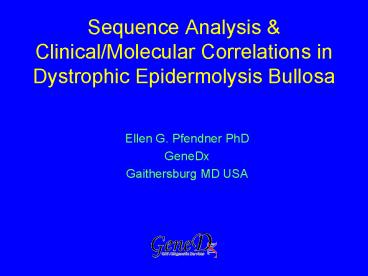Sequence Analysis - PowerPoint PPT Presentation
1 / 26
Title:
Sequence Analysis
Description:
Sequence Analysis & Clinical/Molecular Correlations in Dystrophic ... milia, scars, skin atrophy, mild palmar hyperkeratosis, thin scalp hair, sparse ... – PowerPoint PPT presentation
Number of Views:140
Avg rating:3.0/5.0
Title: Sequence Analysis
1
Sequence Analysis Clinical/Molecular
Correlations in Dystrophic Epidermolysis Bullosa
- Ellen G. Pfendner PhD
- GeneDx
- Gaithersburg MD USA
2
Epidermal Adhesion Network
Desmosomes
Adherens junctions
Ubinuclein
p120ctn
Cadherins Catenins
Desmogleins Desmocollins Desmoplakin
Periplakin
Intermediate filaments
Actin cytoskeleton
K8
K18
Plectin
p120ctn
?
Hemidesmosomes
a6b4
BPAG2
TSP-1
BMZ
Laminin-5
Type VII collagen
Figure 1 Basement Membrane Zone
3
EPIDERMOLYSIS BULLOSA Classification of EB
Level of Category Blistering Protein
Mutated genes
Simplex Basal cell
Keratins 5 14 KRT5, KRT14 Variants Basal
cell/LL interface EB-PA
a6b4 integrin
ITGB4, ITGA6, plectin
PLEC1 EB-MD
plectin
PLEC1 Junctional Lamina lucida laminin A3,
B3 LAMA3, LAMB3,
laminin
C2 LAMC2 Collagen XVII
BPAG2 Dystrophic Sub-lamina
collagen VII COL7A1
densa
4
Why do mutation screening?
To determine risk of recurrence
No family History of EB
No family History of EB
?
- If dominant EB risk to fetus is the risk of
gonadal mosaicism in either parent (2-5). - If recessive EB risk is 25
5
RDEB COL7A1 G2351R/5103CC-gtG
6
EPIDERMOLYSIS BULLOSA Type VII Collagen
Expression in Skin
Normal RDEB
7
IMMUNOFLUORESCENCE OF THE BMZ COMPONENTS
Normal control
EB Type Dystrophic GABEB EB-MD
EB-PA EB-PA
8
R2488X
7597G-gtA
R2331X
COL7A1 Mutations
6656insT
7547ins5
7767delG
4827delAG
R2685X
6501G-gtA
78751G-gtC
R2791W
6269delC
R2741X
R1345X
62165G-gtT
8245insC
R2008C
4048-1G-gtA
6092delG
6082G-gtA
84075G-gtC
8374delG
3841delG
4767delA
8763delG
R20X
3832delG
A80P
3832delGG
326incCG
3842delG
3943insG
G2023N
8471G-gtC
G2025S
4919delG
1171delCT
1172delAT
15071G-gtC
G2040V
1637-1G-gtA
1895delG
G2366S
2186delA
G2067E
G2357S
2279G-gtA
G2315R
R628X
Q905X
9
DEB Mutations
- Only gene involved in DEB is COL7A1
- Mutations span entire coding region and all
splice junctions. - Recessive mutations are found in any exon
- Dominant mutations are more common in exons 73,
74 and 75. - Glycine substitutions are found in the
collagenous domain (Gly-X-Y)
10
Dystrophic EB
Three different screening methods used over a
twelve year period
11
Dystrophic EB Statistics
- Overall detection rate of 60 (371 alleles of
possible 611) over 12 years and using 3 different
screening methods - DHPLC
- CSGE
- Sequencing all exons
- Sequencing has a detection rate of 95
- Few large deletions and intronic mutations
12
RDEB Patient
COL7A1 3088del5ins6/ R1630X
COL7A1 3088del5ins6/ R1630X
13
RDEB Patient
COL7A1 3088del5ins6/R1630X
14
RDEB WITH CONGENITAL ABSENCE OF SKIN
COL7A1 Q2417X/R669X
15
Genotype/Phenotype Correlations in DEB
- Glycine substitutions can be dominant or
recessive - Generally a milder phenotype
- Splice junctions can be dominant or recessive
- Can be mild or severe
- Insertion and deletions are recessive
- Are generally more severe
- STOP codon forming mutations are recessive
- Haploinsufficiency does not cause a phenotype
- These mutations generally result in a more severe
phenotype when found on both alleles
16
Examples of Mild Recessive DEB Mutations
17
Patients with one Dominant and one Recessive
Mutation
18
Patients with One Dominant and One Recessive
Mutationcontinued
19
DDEB PATIENT
- COL7A1 G2043R
NOTE SKIN ATROPHY AND SCARS, DYSTROPHIC NAILS
INVOLVEMENT LIMITED TO EXTREMITIES
20
Dominant vs Recessive DEB
- Dominant DEB
- Probably under represented in sample
- High rate of de novo cases
- Generally a milder phenotype
- Can be either amino acid substitutions, splice
junction mutations or deletions which affect
splicing
- Recessive DEB
- Majority of cases
- No de novo cases in our sample (2 de novo
mutations reported in literature) - Generally a more severe phenotype
- -- Can be insertion/deletions, splice junction,
Stop codon forming or amino acid substitutions
21
EPIDERMOLYSIS BULLOSA Future Areas of
Translational Research
- Development of Novel Treatment Modalities
- - Gene therapy replacement vs repair
- - Bioengineered skin equivalents
- Early Prenatal Diagnosis
- - Preimplantation genetic diagnosis
- - Non-invasive mutation analysis in
- maternal blood
- Surveillance and prevention of carcinogenesis
22
EPIDERMOLYSIS BULLOSA Prospects for Gene Therapy
- Specific molecular defects identified in ten
- different genes of the cutaneous basement
- membrane zone
- The majority of mutations are single-base
- pair substitutions or small insertions or
- deletions
- A candidate disease for gene correction strategy
23
CUTANEOUS GENE THERAPY Goals of Keratinocyte Gene
Transfer
- Efficient targeting of stem cell populations
- allowing sustained expression of the
transgene - Use of specific promoters for stable,
tissue-specific - and modulatable expression of the transgene
- Synthesis and assembly of the protein and
- supramolecular organization defective
- in the disease
24
CUTANEOUS GENE THERAPY The Promise and the
Challenges
- A Fact
- First non-Herlitz Junctional EB patient treated
with - genetically modified keratinocyte grafts (May
2002, - Dr. Michele DeLuca, IDI, Rome personal
- communication)
- Unknown
- The extent of sustained phenotypic reversal?
- The persistence of the skin graft?
- Immune challenge to the graft?
- How to correct extracutaneous manifestations?
25
GENE THERAPY IN DERMATOLOGY A Look to the Future
- Rapid development of novel technologies
- Treatment of single-gene disorders (e.g. EB)
- by early 21st Century
- Strategies to counteract complex pathological
- and biological processes (e.g. skin cancer,
- cutaneous aging)
26
Thanks to the following individuals Jouni Uitto
MD PhD Chair Dept of Dermatology Thomas Jefferson
University Angela Christiano PhD Leena Pulkkinen
PhD Aoi Nakano MD PhD Karl Nielsen Sarah
Fratta Sara Sadowski Sarah Cash MD Roslyn Varki
MD Monjir Bakshi
Supported by NIH/NIAMS DebRA of America and
Families of EB Patients






























